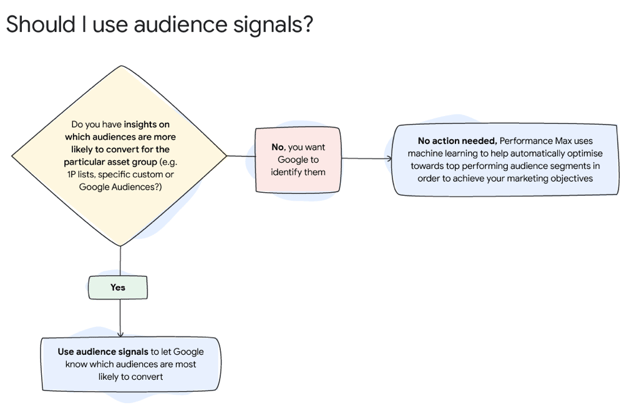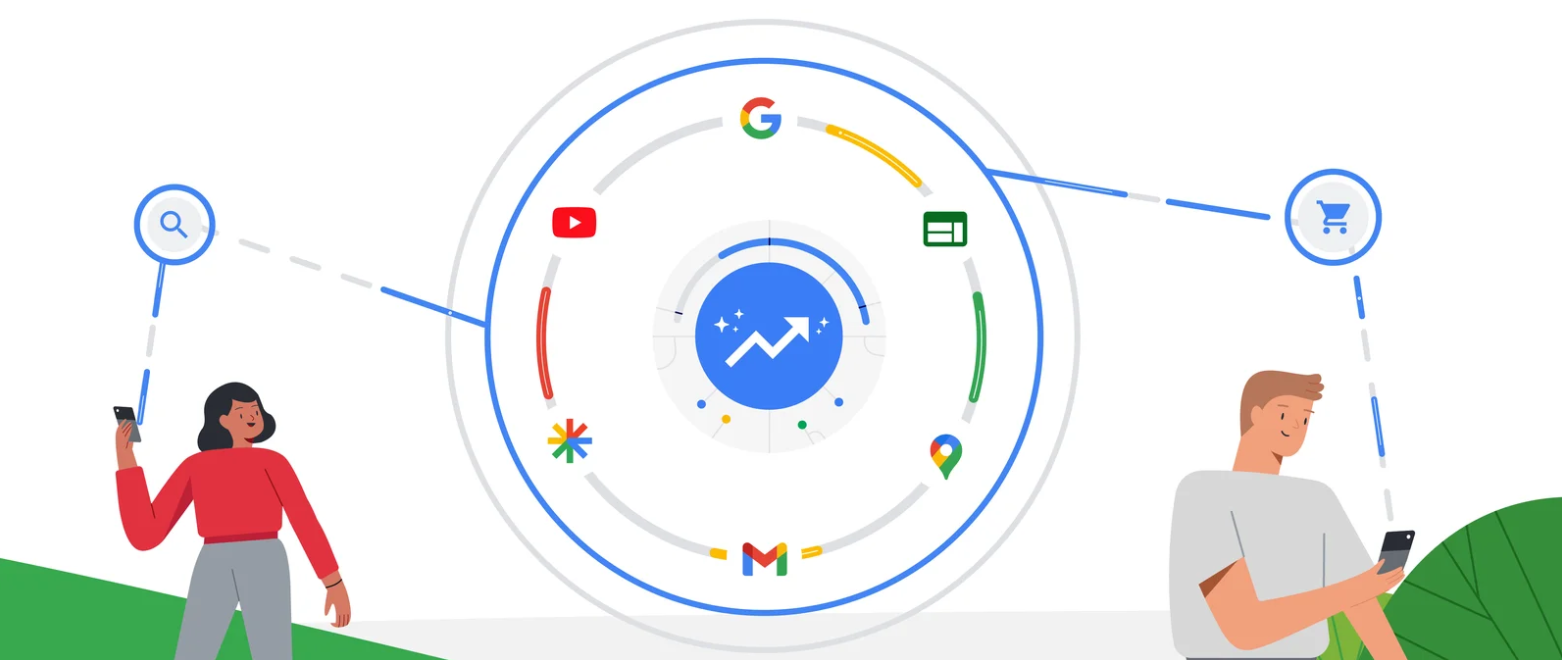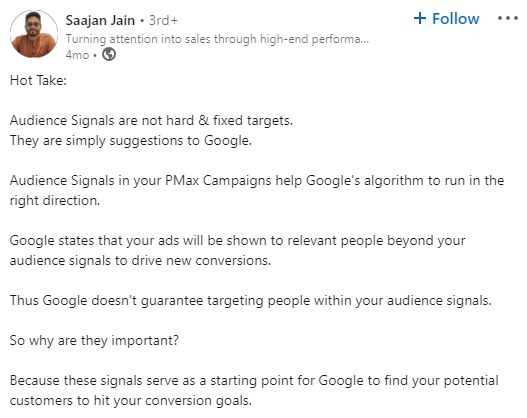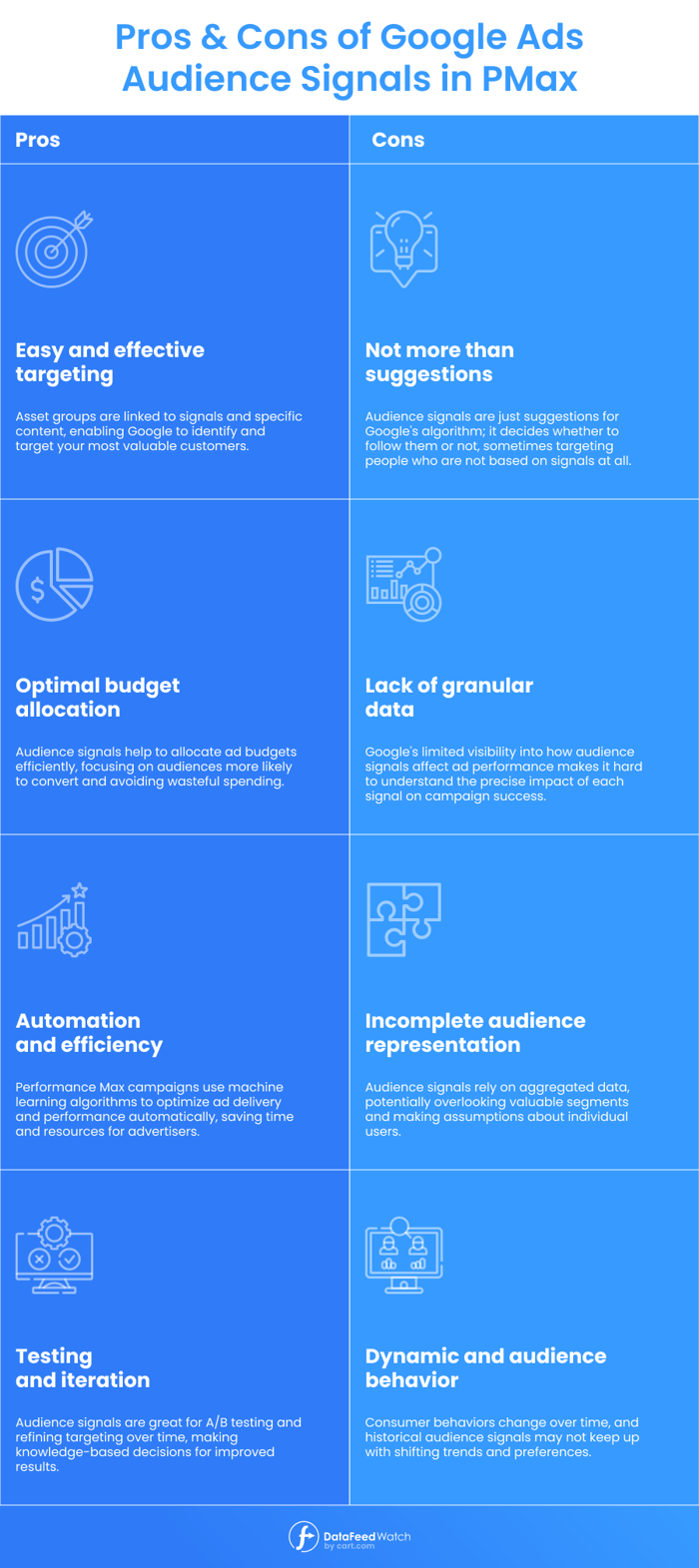- Audience signals are vital in Performance Max campaigns, guiding Google's optimization based on advertisers' goals.
- You should avoid adding all audience signals in one asset group; instead organize them into separate categories for better control.
- It’s worth utilizing existing customer data, remarketing, and customer match lists in your audience signals to find more potential customers.
In the competitive eCommerce world advertisers strive to connect with potential customers and drive conversions. Google's Performance Max (PMax) with all its helpful features emerge as a powerful tool in their arsenal. To further enhance the precision and effectiveness of these campaigns, the integration of audience signals comes into play.
In this article, we will delve into the concept of audience signals and explore their role in optimizing Performance Max campaigns. So, let's dive in and discover how to effectively create audiences and add audience signals to Performance Max for achieving exceptional results in Google advertising.
What are audience signals in Google Ads and who should use them?
Performance Max audience signals are a feature that helps Google's machine learn and optimize your campaigns for better performance by identifying the audiences most likely to convert.

Audience signals best practices | Google
It’s important to understand that these signals are not hard targets but act as helpful suggestions to guide Google's algorithm in the right direction for optimized Performance Max campaigns.
How does Google Performance Max use audience signals?
The data used in audience signals include factors like age, gender, location, browsing history, and search keywords. By understanding these signals, Google's Performance Max can show ads that are more likely to be seen and engaged with by the right people, leading to improved results overall.
Audience signals are tied to an asset group, so they need to be built every time a new asset group is created.
Utilizing audience signals is recommended as it helps guide Google's machine learning algorithms to identify more accurate customers for your business. Strong and well-defined audience lists are essential to avoid wasting advertising budget on irrelevant audiences. You can also update the signals using first-party data, allowing for quick gains and improvements when performance starts to lag.

Performance Max machine learning | Google
Key benefits of using audience signals
Online advertising and marketing teams encounter various difficulties when trying to connect with the appropriate audience at the perfect moment. Fortunately, Performance Max (PMax) campaigns offer solutions to some of these challenges.
Easy and effective targeting
In the past, marketers had to search for the right audience and then tailor their approach to each segment, providing a personalized experience through relevant messages. However, with PMax, you can create asset groups linked to signals and specific content. Google utilizes this data to identify and target your most valuable customers effectively.
Optimal budget allocation
Audience signals help in allocating ad budgets more efficiently by focusing on audiences that are more likely to convert. This reduces wasteful spending on audiences that may not be interested in the product or service.
Automation and efficiency
Performance Max campaigns use machine learning algorithms to optimize ad delivery and performance automatically. This automation saves time and resources for advertisers, allowing you to focus on other aspects of your marketing strategy.
Testing and iteration
Audience signals facilitate A/B testing and experimentation with different audience segments. You can refine your targeting over time, identifying the most effective signals for your specific goals. Then they can make appropriate knowledge-based decisions.

Understanding the challenges of audience signals
Audience signals, while valuable in optimizing advertising campaigns, do have some challenges and limitations. Here are some points to consider:
Not more than suggestions
As we already know, audience signals are just suggestions for Google, just like PMax Search Themes. The algorithm decides whether to follow them or not. Often, Google goes beyond your signals and targets more people just to get cheaper conversions.
Lack of granular data
Google often provides limited visibility into the specifics of how audience signals influence ad performance. This lack of transparency can make it difficult to understand the precise impact of each signal on campaign success. Even if you make changes to your audience signals and see better results, you can't be sure it's all because of those changes.
Incomplete audience representation
Audience signals are based on aggregated data, which might not fully capture the complexity of individual users. This can lead to assumptions and generalizations about audiences, potentially overlooking valuable segments.
Dynamic and evolving audience behavior
Consumer behaviors change over time, and relying solely on historical audience signals might not be sufficient to keep up with shifting trends and preferences.

Structuring audience signals for Performance Max
When it comes to incorporating audience signals into your PMax advertising strategy, Google suggests placing all signals within a single asset group. However, we advise against following this recommendation.
Google doesn't directly show which audiences are performing well. Google only tells you about the asset groups that are doing well by checking the asset group details and listing group metrics.
Therefore, our best practice approach is to create multiple asset groups, each for each specific audience signal. By doing so, you gain better control over your campaign and can evaluate the performance of each asset group (with a specific signal) individually. This approach proves particularly valuable when targeting a very big product catalog for an eCommerce business.
.png?width=700&height=278&name=image%20(22).png)
Creating audience signals within an asset group | PMax in Google Ads
Having separate asset groups for different audience signals allows you to make well-informed decisions regarding your campaign's structure, strategy, and ad creative. You can optimize your advertising efforts effectively for each audience segment.
3 ways of setting up audience signals for Performance Max
Google Performance Max audience signals are included in asset groups. This method enables you to create ads that deliver the right message to a particular audience.
Before you can add the right audience signal to your chosen asset group you need to set up your audience. There are 3 main ways of doing it:
- Creating custom segments & keyword lists
- Using first-party data (converters + non converters)
- Adding demographic and interest-based targeting
1. Grouping audience in custom segments & creating keywords list
Custom segments are a great tool for advertisers to reach specific groups of users based on their recent online activities. This could include the searches they've done, apps they’ve downloaded or the websites they've visited.
When creating a custom segment, you can enter keywords related to your ideal customers' interests or relevant to your products. You do it under “People who searched for any of these terms on Google” (see screenshot below).
This means you can reach your target audience without paying extra to appear on the top search results. All you need to do is enter the right keywords when creating a custom segment, and you're all set!
Custom segments & Keyword lists - useful tips:
- Target keywords related to people’s interests
Using keywords that relate to people's interests can often lead to more effective targeting in advertising. The easiest way to explain this is with a real-life example.
An example of camping gear products:
Let’s say that you are targeting people who buy camping equipment - the products you sell.
To effectively reach your target customers, you might consider targeting keywords related not only to camping gear but also to broader outdoor activities. By identifying keywords and websites associated with hiking, camping destinations, and adventure travel, you can tap into the interests of outdoor enthusiasts.
When these users are already researching and planning their next outdoor adventure, they might also be in need of climbing and scuba diving equipment, for example. By strategically targeting these interest-based keywords, you can anticipate their needs and showcase your products as the perfect companion for their upcoming trips.
This approach allows you to connect with potential customers at the right moment and increase the chances of converting their interest into a purchase.
.png?width=700&height=353&name=image%20(23).png)
Creating custom audience segments | PMax in Google Ads
- Target your competitor’s brand names
Another useful strategy is to inform Google about your direct competitors. It's essential to select competitors with a product offering similar to yours, as Google examines the entire website, not just specific sections of it. This information helps Google to create a look-alike audience for your ads.
- Ensure that the competitor you target is similar in terms of advertising budget and company scale to you.
- Reduce the niche as much as possible. Be specific.
To achieve greater specificity, you can choose to target the product pages of your competitor. For example, if you offer a product similar to one sold by a much bigger retailer it's better to focus on the specific product's URL rather than the entire website.
You can easily set this up through the "People who browse types of websites" option in custom segments. By doing so, you can tailor your targeting approach and make your advertising efforts more effective.
.png?width=700&height=474&name=image%20(24).png)
Creating custom audience segments using competitor’s names | PMax in Google Ads
2. Uploading your data
What is your data? Your data consists of users who have engaged with your site. In fact, they form a remarketing list and a customer match list. Google takes this list of customers and identifies other people who may be interested in your products or services.
If you're unsure about building audiences, you can refer to the data from your old Smart Shopping campaign. It can serve as a helpful reference in creating effective audience signals for your Performance Max campaigns.
Adding your data to audience signals: list of people who DIDN’T convert
The first step is to include the website visitors who haven't made a purchase yet. These visitors might become valuable customers, but only if you know that the source you are getting them from is reliable.
If you've been using Google Ads to bring traffic to your website, and you know that this traffic gives a high chance of making a purchase, then it's a good idea to include this group in your advertising efforts. But you should always be selective about which group of people you want to show to Google as potential buyers. Some organic traffic is just not of a quality, you’re looking for and will never convert.
.png?width=700&height=506&name=image%20(25).png)
Creating an audience signal based on your own data | PMax in Google Ads
Adding your data to audience signals: list of people who DID convert
This audience consists of people who have already made a purchase from you. The main goal here is to inform Google about your existing customers. By understanding this data, Google's machine learning algorithm can identify and target new audiences that share similarities with your current buyers. This new audience will likely be of high quality since they too are potential buyers.
The success of this tactic will vary depending on your current stage of online sales. For a new eCommerce marketing campaign on a brand-new website, you might not have an existing audience to include. However, if you've previously run a Google Ads campaign or have data from other traffic sources, you may already have a valuable list of past buyers.
You also need to assess whether the converting users in this audience align with the product you're promoting in the Performance Max (PMax) campaign you're adding them to. It's essential to ensure the relevance of the audience to maximize the success of your PMax campaign.
.png?width=700&height=468&name=image%20(26).png)
Creating an audience signal based on your own data | PMax in Google Ads
3. Adding interests, habits and demographics
These segments are groups of characteristics that you believe match your ideal customers, such as their gender, marital status, parental status, age, household income, or the industries they are interested in (.g., business services, sporting goods, consumer electronics, apparel). The more precise and accurate you are in defining these segments, the more effective your marketing will be.
How you use these segments depends on the products you offer and your understanding of your target audience. For example, specifying household income can help identify potential customers with the means to buy high-end luxury goods. Knowing the gender of your audience can assist in marketing make-up items etc.
This approach to audience building can be very useful if your products are aimed at a very specific type of consumer, as it can drastically reduce the number of irrelevant clicks.
.png?width=700&height=506&name=image%20(27).png)
Creating audience signals based on demographics for PMax | Google Ads
Additionally you can indicate different categorized audiences:
- Detailed Demographics
This approach allows you to reach specific user groups based on long-term life facts, such as age, gender, marital status, and household income.
- Life Events
By targeting user groups during significant life milestones, you can connect with them at the right moment when they might be more receptive to relevant products or services. For example, reaching out to people during weddings or moving to a new house can present unique opportunities for effective marketing.
- Affinity
This targeting option enables you to connect with user groups based on their passions, habits, and interests. Google generates these audiences by utilizing data from users' browsing history, search queries, and other online interactions.
- In-market
This powerful strategy allows you to target user groups based on their recent purchase intent. Google identifies potential customers who are actively looking to buy specific products or services based on their previous web activity and search history.
How to add audience signals to Performance Max
While it is not obligatory to add audience signals to PMax, incorporating them can be helpful in instructing machine learning models on the best approach to optimize your campaign.
Adding audience signals to a PMax campaign is very simple. The more difficult part is creating and selecting the right audience segment. For now, see 6 basic steps on how to add audience signals to your asset group.
- Go to the Audiences section below your chosen asset group.
- If you have already built audiences, pick Select an Audience. If not, choose Create an Audience.
- Give your audience a unique name.
- Add your own data if you have it.
- Include custom segments if needed.
- When finished, click on Save Audience.
.png?width=700&height=498&name=image%20(28).png)
Setting up a new audience signal | Google Ads
1. How to add audience signals to Performance Max: based on custom segments
To use this type of audience, you must add the audience signal to an asset group.
- Go to Audiences section beneath your asset group..
- Select Create an Audience if you haven't created the audience signal yet.
- Name your audience signal.
- Go to the Add Custom Segment section.
- Name your custom segment and define the criteria for it.
- Save your custom segment.
- Save your audience signal.
2. How to add audience signals to Performance Max: based on your own data
To use this type of audience, you must add the audience signal to an asset group.
- Go to Audiences section beneath your asset group.
- Select Create an Audience if you haven't created the audience signal yet.
- Name your audience signal.
- Upload your customer lists using the Add your Data option.
- Save your audience signal.
Google can use the customer list to identify and reach more people who share an interest in your offerings.
3. How to add audience signals to Performance Max: based on demographics & interests
To use this type of audience, you must add the audience signal to an asset group.
- Go to Audiences section beneath your asset group.
- Select Create an Audience if you haven't created the audience signal yet.
- Name your audience signal.
- Choose Demographics and Interests in the audience creation options:
- Under Demographics, you can select options like age, gender, parental status, or household income to narrow down your audience.
- Under Interests, you can specify particular interests, hobbies, or behaviors that align with your target audience.
- Save your audience signal.
Audience signals Google Ads best practices
Here are some best practices to follow when creating audiences and adding audience signals to Performance Max campaigns. They can increase your campaign performance. Foran overview of PMax's general practises see our checklist.
1. Start with very specific audience signals and leverage first-party data
We recommend starting with highly specific signals, such as first-party data signals, which consist of your own data. This way you can have control over the quality of them.
These specific signals can help you connect with the most relevant audience segments right from the beginning of your campaign. As you gain insights and optimize your targeting, you can gradually expand to incorporate additional signals to further broaden your reach while maintaining relevance and effectiveness.
For eCommerce, you can come up with segments like: converters, non-converters or even narrower if you are in the possession of such data: repeat customers, low value customers (buying on bargains) or high value customers (big spenders).
Integrating with a Google Shopping management system from DataFeedWatch you can easily create custom labels to segment your audience.
What if you don’t have enough data?
If you don't have enough data points, but have already made sales online, although you don't have audience lists in your Google Ads or Analytics account, you can still leverage your customer lists using the customer matching feature. To do so, you can upload your customer lists to Google Ads Audience Manager.
You can also just use broader first party signals. But remember, that in most cases, the more specific the better. Just test and see what works well for you.
2. Don’t target interests and detailed demographics individually
Interests and detailed demographics often cover a wide range of audiences. It's generally not advisable to target them individually at first.
Instead, we suggest reaching your specific targets with a narrower focus and assessing performance. If you achieve your desired results and see good performance, you can then experiment with broader audience signals to increase reach, such as adding interest-based audience signals.
3. Let Performance Max Insights guide you
To expand a Performance Max campaign effectively, the insights tab provides valuable starting points as it reveals where new customers can be found.
As the campaigns gain traction and collect conversion data, Performance Max highlights the top-performing audiences. You can make use of this third-party data to enhance your account and help Performance Max in further scaling.
After identifying successful audience signals, you have several ways to scale your campaign. You can leverage the data to reach new audience segments or optimize your creative to improve the existing reach.
4. Don’t forget about highly relevant ad creative
To increase your reach, optimize your ad creative for specific audiences. This helps your ads connect better with these segments and boosts desired actions.
For instance, if you notice a new search query category driving high conversions and growing traffic in the Search Terms Insights of a PMax Campaign, it might be a new segment to scale into. Customize ad creative to suit the needs and intent of this audience.
Create a new asset group targeting the audience signal from the identified search keywords in the insights tab, along with tailored ad creative.
You should do it because educating the machine matters. If your improved ad creative resonates with a specific audience signal, Google tests it. If conversions improve, Google prioritizes showing your tailored ads to this audience.
5.Examine audience signals to find new relevant audiences
Using audience Insights will give you insight into how much of your website's traffic comes from different Google audience categories.
For instance, you might find that a significant portion of your website traffic consists of users searching for workout equipment. Whatever you sell: apparel, books or electronics, this information can be valuable and open up new possibilities. You can assess which products from your catalog might interest this audience the most, customize your ad copy to connect with them better, and explore untapped advertising channels like Search, YouTube, or Discovery to reach them effectively.
6. Keep on testing
While PMax's automation and machine learning capabilities are revolutionizing the creation of Google ad campaigns, it's important not to rest on your laurels and remember that human involvement remains key.
The process of testing audience signals is fundamental to the success of Performance Max campaigns. We need to be actively involved in steering and monitoring these automated campaigns. Human insights are incredibly valuable in helping the machine navigate in the right direction and make smarter decisions.
Constantly optimizing your Google Performance Max campaigns through testing can yield remarkable results, leading to enhanced performance and improved ROI.
By analyzing and adjusting audience signals, you can gain a deeper understanding of your target audience and refine your strategy accordingly.
7. Combine your own data with some of specific custom segments
If you want to be as specific in building custom segments for PMax audience signals as possible, you can try to combine your own data with Google's data on people who are already actively searching for the products you sell. This way, you can be sure that you have done your best to target the right audience.
You can combine:
- Up to 50 of your best performing search terms (custom in-market)
- List of people who looked for certain search terms on Google (custom in-market)
Summary
In conclusion, by leveraging audience signals in Performance Max, you can create more targeted and personalized ads, reaching the right audience at the right time.
Through this article, we have discussed the key steps involved in adding audience signals to Performance Max. We began by understanding the importance of audience signals and how they can impact your campaign performance. We then explored the process of setting up and managing audience signals, ensuring that you have the necessary data to guide your advertising efforts.
Find out more about the core of the Performance Max campaign.
Have you already started exploring the world of Google Performance Max audience signals? Share your experiences with us by leaving a comment below.
